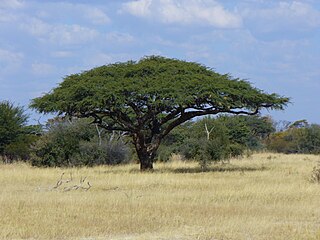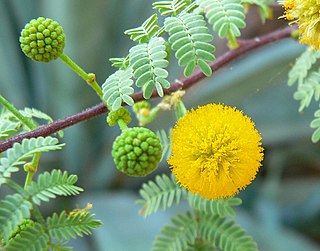Vachellia sphaerocephala is a plant of the family Fabaceae. The name comes from the shape of the thorns which do indeed resemble the horns of a bull. The tree has a strong, symbiotic relationship with a species of stinging ant, Pseudomyrmex ferruginea. This tree is endemic to Mexico.

Vachellia erioloba, still more commonly known as Acacia erioloba, is a tree of southern Africa in the family Fabaceae. Its preferred habitat is the deep dry sandy soils in parts of South Africa, Botswana, the western areas of Zimbabwe and Namibia. It is also native to Angola, south-west Mozambique, Zambia and Swaziland. The tree was first described by Ernst Heinrich Friedrich Meyer and Johann Franz Drège in 1836. The camel thorn is a protected tree in South Africa.

Vachellia caven is an ornamental tree in the Fabaceae family. Vachellia caven is native to Argentina, Bolivia, Chile, Paraguay, and Uruguay. It grows four to five metres tall and bears very stiff and sharp white thorns up to 2 cm in length. It blooms in Spring, with bright yellow flowers 1 cm to 2 cm in diameter.

Vachellia nilotica is a tree in the family Fabaceae. It is native to Africa, the Middle East and the Indian subcontinent. It is also a Weed of National Significance and is an invasive species of significant concern in Australia.

Vachellia constricta, also known commonly as the whitethorn acacia, is a shrub native to Mexico and the Southwestern United States, with a disjunct eastern population in Virginia and Maryland.
Vachellia nilotica subsp. adstringens is a perennial tree. It is not listed as being threatened. Some common names for it are cassie, piquants blancs and piquant lulu. Its geographic distribution includes Africa, Asia, the Indian Ocean area and the Middle East.

Vachellia xanthophloea is a tree in the Fabaceae family and is commonly known in English as the fever tree. This species of Vachellia is native to eastern and southern Africa. It can be found in Botswana, Kenya, Malawi, Mozambique, Somalia, South Africa, Swaziland, Tanzania, Zambia and Zimbabwe. It has also become a landscape tree in other warm climates, outside of its natural range.
Vachellia anegadensis (pokemeboy) is a species of legume in the Fabaceae family. It is found only in the British Virgin Islands. Its natural habitats are subtropical or tropical dry forests, subtropical or tropical dry shrubland, sandy shores, and rural gardens. It is threatened by habitat loss.
Vachellia belairioides is a species of legume in the Fabaceae family. It is found only in Cuba, confined to Holguín Province in northeastern Cuba. It is threatened by habitat loss.
Vachellia bucheri is a species of legume in the Fabaceae family found only in Cuba.
Vachellia cernua is a species of legume in the Fabaceae family. It is found only in Somalia, and is threatened by habitat loss.
Vachellia chiapensis is a species of leguminous tree in the Fabaceae family. It is found only in Mexico.
Vachellia daemon is a species of legume in the Fabaceae family found only in Cuba. It is threatened by habitat loss.
Vachellia origena is a species of legume in the Fabaceae family. It is found in Eritrea, Ethiopia, and Yemen.
Vachellia permixta is a species of legume in the Fabaceae family. It is found in Botswana, the Northern Provinces of South Africa, and Zimbabwe.
Vachellia prasinata is a species of legume in the Fabaceae family. It is found only in Ethiopia. It is threatened by habitat loss.
Vachellia roigii is a species of legume in the Fabaceae family found only in Cuba. It is threatened by habitat loss.
Vachellia zapatensis is a species of legume in the Fabaceae family found only in Cuba.

Vachellia is a genus of flowering plants in the legume family, Fabaceae, commonly known as thorn trees or acacias. It belongs to the subfamily Mimosoideae. Its species were considered members of genus Acacia until 2009. Vachellia can be distinguished from other acacias by its capitate inflorescences and spinescent stipules. Before discovery of the New World, Europeans in the Mediterranean region were familiar with several species of Vachellia, which they knew as sources of medicine, and had names for them that they inherited from the Greeks and Romans.

The splendid thorn is an Afrotropical tree species.









